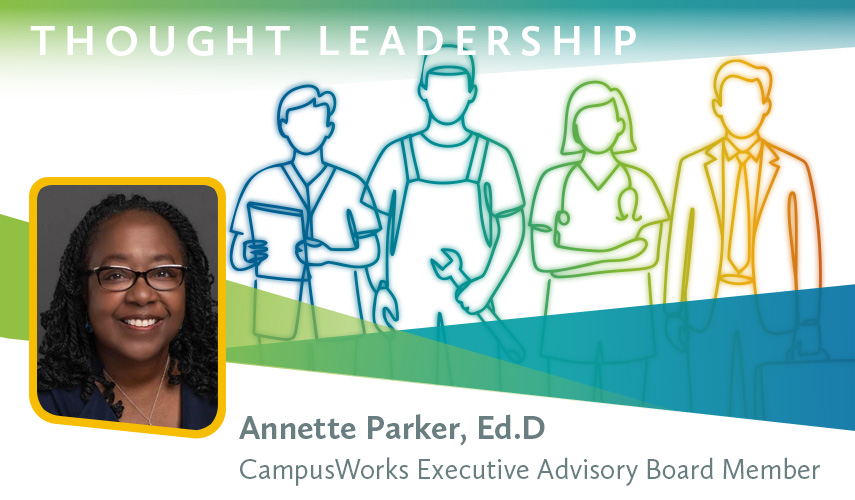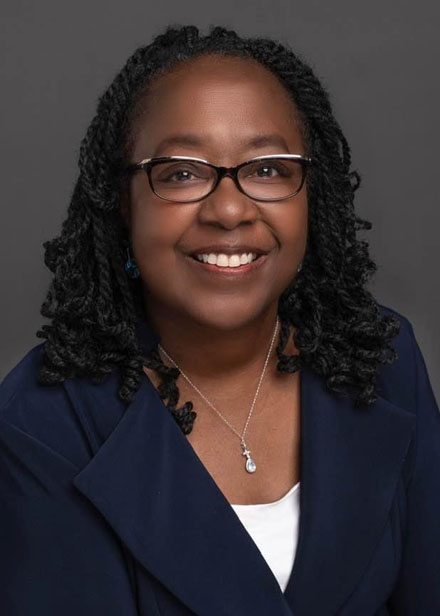
EAB Thought Leadership
The Power of ‘We’: Building Workforce Partnerships That Last
By Annette Parker, Ed.D., Retired President, South Central College
I’m writing this from the basement of a once-rustic cabin on Idlewild Lake in northern Michigan. For forty years, my husband and I have brought our family here to hunt, fish, and breathe. We always said, “When we retire, we’ll spend our summers at the lake.” That dream took longer than we expected—my trajectory bent from the auto industry into higher education—but the long view helps. It reminds me that the most important work presidents do isn’t a program launch or a ribbon cutting. It’s building a “we” that outlasts any one of us.
That “we” is what keeps communities strong—especially in rural metropolitan statistical areas (MSAs) where sustainability is an open question. Employers ask, “Will the future workforce be here?” Local leaders worry, “Will our kids come back?” The answer is yes, if we align our colleges with the communities we serve in ways that are practical, honest, and built to last.
The real challenge isn’t speed—it’s alignment
I hear this everywhere: “Colleges are too slow.” On our side, we sometimes think employers are impatient or don’t understand quality. The truth is simpler: we don’t speak the same language.
In higher ed, we live inside accreditation cycles, curriculum governance, faculty workload, and financial aid rules. In business and industry, leaders are juggling product timelines, regulatory approvals, capital planning, and shift schedules. When we don’t translate those realities for one another, misunderstandings masquerade as opposition. What industry experiences as delay may be our obligation to do program approval the right way. What colleges experience as pressure may be industry’s real cost of missing a hiring window.

Annette Parker, Ed.D.
As president, I learned that my first job in workforce partnerships was chief translator. Bring everyone to the table. Name the acronyms. Map the processes. Put the barriers on the wall where everybody can see them. When partners understand not only what we’re doing but why—and on what timeline—the friction drops and trust grows.
How partnerships mature: from “you” and “us” to “we”
Before I became a college president, I led a National Science Foundation–funded center in automotive manufacturing, working across 14 states with American, European, and Asian automakers and with community colleges. The central research question was simple and audacious: Could competing colleges and competing companies actually collaborate? Could Toyota and General Motors co-design curriculum and pathways that benefit everyone?
We used the Wilder Foundation’s Collaboration Factors Inventory to move through stages defined by The Collaboration Challenge: How Nonprofits and Businesses Succeed through Strategic Alliances by James E. Austin.
We focused on environmental factors as well as process and structural elements to develop and maintain a unified vision among all partners.
We measured the partnerships using Austin’s stages in the following way:
- Philanthropic — low level of commitment. The nature of the relationship was merely that of a charitable donor and recipient in support of a new curriculum.
- Transitional — increased engagement. The partnership featured strong employer involvement through participation on advisory boards and various committees, financial and equipment contributions, and the provision of internships and apprenticeships. Additionally, employers offered staff support to help achieve shared goals. While these efforts were valuable, the partnership remained somewhat fragile, highlighting the importance of maintaining a focus on essential success factors.
- Integrated “We” mentality. As engagement progressed, the level of commitment shifted from minimal to substantial, with partners contributing greater financial support, in-kind resources, and expertise. Activities expanded, and involvement deepened across all levels of the partnership. This heightened value transformed the relationship from straightforward to multifaceted, necessitating consistent management to maintain and strengthen collaboration.
We knew we were in the third stage when partners stopped saying “GM will…” or “the college will…” and started saying “we will.” When employers said to us, “We are creating career pathways,” or they said, “we (all automotive partners) compete on our products not on the skills of our workforce.” I knew then we had crossed the line from cooperation to commitment. That’s where resilience lives.
A cradle-to-career coalition that changed the conversation
At South Central College, the Faribault campus sits in a community that has asked hard questions about its future. The Chamber of Commerce took the lead in the city’s plan for 2040, in which Excellence in Education became the number one goal for the city. This led to the development of a cradle-to-career coalition—business and industry, the city, the school district, and the college working together—because everyone understood that the old, siloed approach would not sustain a workforce.
One early barrier surfaced immediately: childcare capacity. Without reliable childcare, people can’t work or learn. The Chamber’s leader—who will still tell you he “loves” how this partnership works—secured grants, supported small businesses to open daycare facilities, and expanded the number of seats. That’s workforce infrastructure as surely as a welding lab or a broadband line. And because we met every two weeks, across sectors, we kept momentum. Importantly, I encouraged the Chamber to lead. Partnerships endure when authority is distributed. We designed it to survive leadership transitions, including mine.
The lesson is straightforward: when you understand the whole landscape—what employers need, what communities need, what families need, and what students need academically—you can braid solutions together that no single institution can deliver alone.
The work of the future: short-term Pell and stackable pathways
I served on MIT’s Work of the Future advisory board alongside people whose minds still humble me. We made one important choice of words: we didn’t study the “future of work” as something happening to us; we focused on the work of the future, because work isn’t going away. Skills are changing.
That shift demands career pathways of stackable, industry-recognized credentials—on-ramps, off-ramps, and on-ramps again, so people can attain skills that lead to work, with the ability return quickly to gain a new skill that advances their work. Community colleges have been doing this for decades. What’s new is the scale and urgency, especially as short-term Pell becomes real. Presidents who prepare now—mapping noncredit to credit, validating with industry, building strong community alliances, and aligning student services and financial aid to shorter learning cycles—will win. And our communities will, too.
I’ve watched master’s and bachelor’s degree holders return for a specific skill. As a faculty member, I’ve taught engineers nearing retirement who wanted a new tool so they could keep contributing from home. I’ve seen noncredit learners convert to credit programs and then transfer into degrees. This is the future—really, the present—of mobility.
Kill the silos: integration is strategy
Here’s where many institutions struggle. We’ve built rich noncredit (workforce) offerings on one set of systems—say, a CRM like Salesforce—while our for-credit programs live in the student information system. Those tech stacks don’t talk. Students fall into cracks. Leaders lack sightlines. And when the policy environment shifts (as it is with workforce Pell), we discover our architecture wasn’t designed for what’s next.
If you’re picking systems or re-platforming, bring the workforce side into the room. I’ve seen statewide decisions get made without them, and the cost shows up later as fragmented data, duplicated effort, and student friction. Shared-services partners, like CampusWorks, can help with data integration, pathway visibility, and the handoffs that make a learner’s journey seamless. But the strategic decision is ours: noncredit and credit are not separate houses. They are one home with many doors.
For a living example of on-ramps that work, look at places like Wake Tech in North Carolina. They are building pathways that support a critical sector of their regional economy, where state funding has long supported short-term workforce courses that lead students directly into two-year programs and onward. When we connect the dots, people move—and communities grow.
University transfer without the roadblocks
Another friction point is transfer. Too often, students waste time and money repeating learning because credits don’t articulate. Presidents ask, “Why is this still so hard?” Candidly, much of it is in our faculty equivalency conversations. University faculty want to ensure coursework is truly comparable, and that’s appropriate. But sometimes bias about credentials or disciplinary frames slows everything down. And sometimes there’s fear—what we call “butts in seats.”
Here’s how I frame it: universities lose a great many students during the first two years. By junior and senior year, classes are smaller not because programs aren’t worthy, but because attrition is real. A strong two-year/four-year partnership fills your junior and senior classes with students who are ready to thrive. Everybody wins: the student, the college, the university, the employer, and the region.
Look at WSU Tech and Wichita State in Kansas. The technical college president sits on the university president’s cabinet. They aligned names, leadership, and pathways—especially in aviation, the region’s economic backbone. Students start with short-term credentials, move through the associate, and transition seamlessly to WSU.
That’s what “we” looks like.
Why this matters most in rural MSAs
The sustainability of rural communities is not an abstraction to me. I’ve sat with chambers, city councils, and employers who wonder whether their children will return after they leave town for higher education, or whether a plant expansion is possible without talent. The encouraging trend is that employers and government are ready to partner. They want to invest where colleges are conveners and truth-tellers. Add civic engagement to technical skill, and you graduate not just employees but citizens who stay, serve, and lead.
Three practices presidents can start this quarter
- Cast a shared vision—and support it at every level. Align your cabinet, faculty leadership, student services, and external partners to one measurable regional goal. If your Chamber has a 2040 plan, be in it. If your EDC has a cluster strategy, braid your pathways to it. The test of maturity is whether your partners start saying “we.”
- Be truth-tellers about barriers. Put accreditation milestones, curriculum timelines, plant startup dates, and software incompatibilities on the table. Translate the why behind each. You’re not just solving one program; you’re building muscles your community will need again and again.
- Integrate for sustainability. Merge noncredit and credit pathways—on paper and in your systems. Map every short-term credential to next steps. Connect data so learners can move and leaders can see. Distribute leadership so the work survives personnel changes—yours included.
If you like metrics (I do), track: time-to-launch for programs, noncredit-to-credit conversion rates, repeat employer engagements, barrier removals (like new childcare seats), and junior/senior “backfill” from transfer partners. Those are signals that your “we” is getting stronger.
The long view from the lake
When I left the auto industry, my husband and I thought we’d be retired before fifty, spending our days fishing and biking. Life had other plans. I’m grateful it did. The years I spent translating across acronyms, pulling chairs up to crowded tables, and hearing partners say “we” changed me—and, I believe, helped communities become more resilient.
If you’re a president reading this, here’s my encouragement: lean into the “we.” Convene it. Name the barriers. Share the credit. Design for the day you’re not in the room. Programs will come and go. Buildings will age. The “we” you build—grounded in shared vision, truth-telling, and integration—will keep working long after you’ve headed to your own lake.
And that’s a legacy worth leaving.

